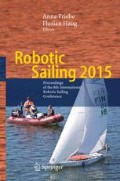Abstract
This article is devoted to the mathematical modeling of a nonconventional sailing platform, which is called a mast-free (or kite) sailing platform. The platform is based on the modern sail type called “kite”. It is a semi-rigid concave wing, which is used for towing water surface objects by wind power. Systems based on the kite successfully evolved over the past 10 years as an independent high-tech water sport. Mast-free sailing platforms managed by human allow them to travel long distances in a wide range of weather conditions. It is necessary to make the platform completely autonomous. To create an automatic control system for this new sailing platform it is necessary to have a mechanical model of the platform. This model should be linear in proximity of its equilibrium states for steady state calculations. All automatic stabilization theory is applicable to use within the linearized model.
Access this chapter
Tax calculation will be finalised at checkout
Purchases are for personal use only
References
The Official Website of the International Kiteboarding Association: http://internationalkiteboarding.org/
Guinness World Records: http://www.guinnessworldrecords.com/world-records/longest-journey-kite-surfing-(male)
Loyd ML (1980) Crosswind kite power (for large-scale wind power production). J Energy 4(3):106–111
Nedeleg B et al (2015) 6 DOF Simulations for Stability Analysis of a Hydrofoil Towed by Kite. In: 5th high performance Yacht design conference. Auckland, 10–12 March 2015
Leloup R et al (2014) Estimation of the Lift-to-Drag ratio using the Lifting line method: application to a leading edge inflatable kite. In: Robotic airborne wind energy. Springer, Heidelberg, pp. 339–359
Bertorello C, Oliviero L (2008) Surf hydrodynamics. In: Hiper 08 international conference 17–19 Sept 2008, Napoli, Italia, pp. 281–290
Dyneema Official Site: http://www.dsm.com/products/dyneema/en_GB/home.html
Cabrinha Official Site: http://pr.cabrinhakites.com
Zaicev P, Formalskii A (2008) Independent longitudinal movement of the wing: mathematical modeling, control synthesis. Russian Academy of Sciences, theory and control systems
Ivanov P (1996) Design, creation and testing of the wing. Moscow
Author information
Authors and Affiliations
Corresponding author
Editor information
Editors and Affiliations
Rights and permissions
Copyright information
© 2016 Springer International Publishing Switzerland
About this paper
Cite this paper
Aprosin, K., Tavlintcev, A., Semenenko, S., Shorikova, M. (2016). Kite Sailing Platform Mathematical Model and Stabilization. In: Friebe, A., Haug, F. (eds) Robotic Sailing 2015. WRSC/IRSC 2015. Springer, Cham. https://doi.org/10.1007/978-3-319-23335-2_5
Download citation
DOI: https://doi.org/10.1007/978-3-319-23335-2_5
Published:
Publisher Name: Springer, Cham
Print ISBN: 978-3-319-23334-5
Online ISBN: 978-3-319-23335-2
eBook Packages: EngineeringEngineering (R0)

